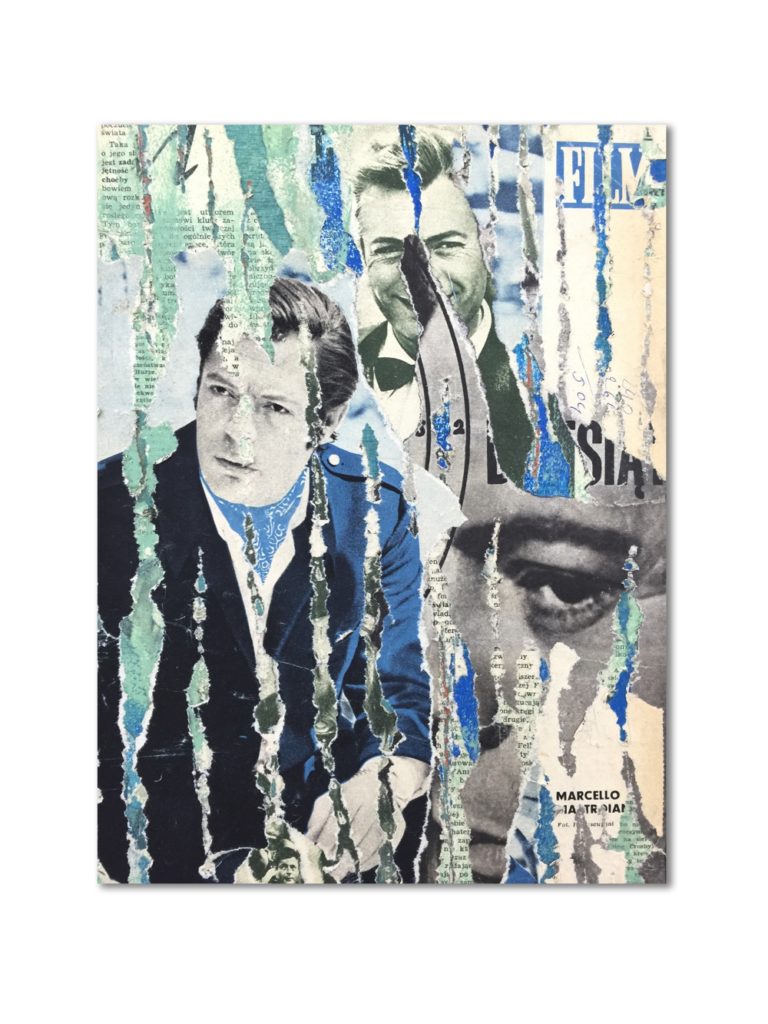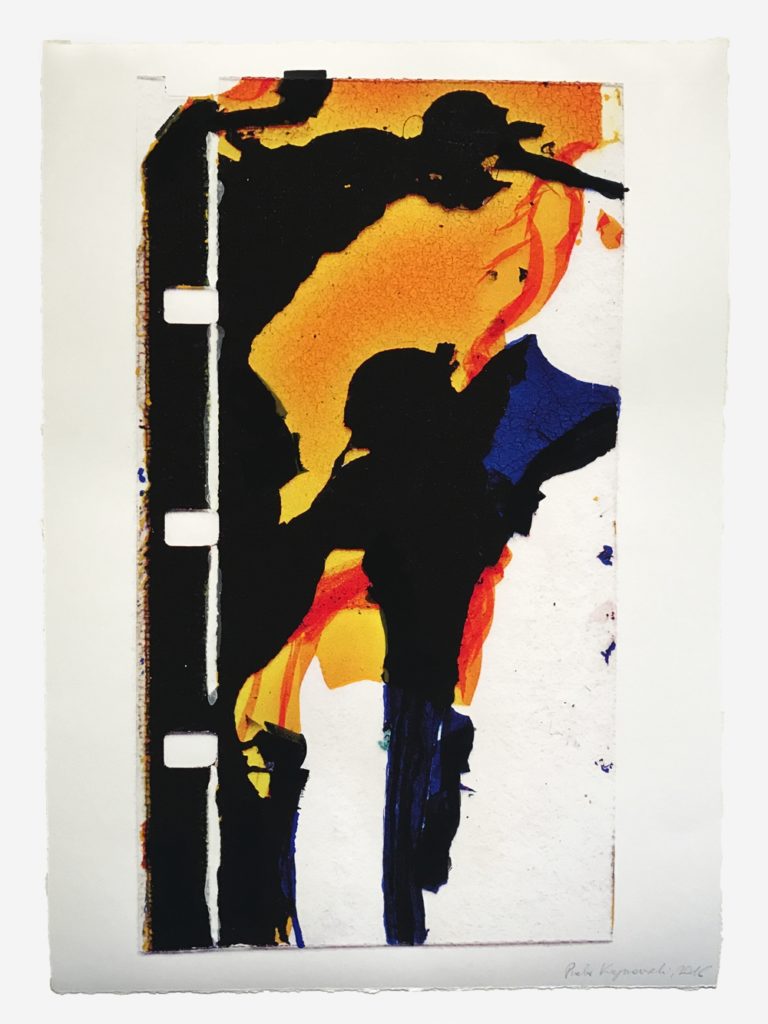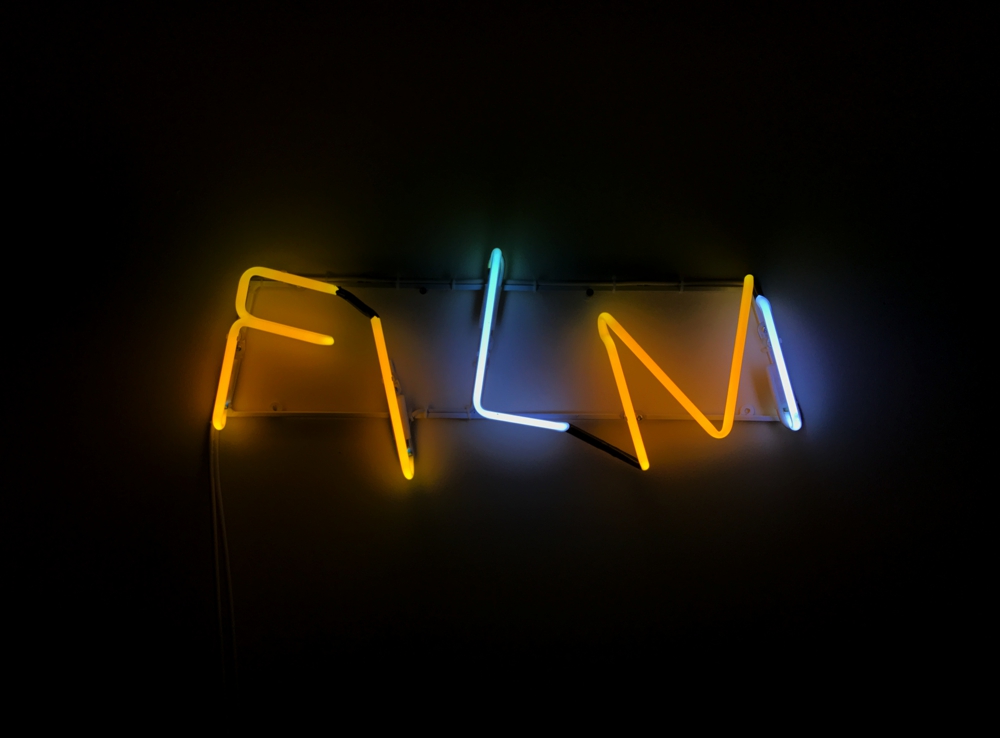
Self portrait, studio, Piotr Krzymowski.
Piotr Krzymowski is an up-and-coming Polish artist and graduate of Central Saint Martins College of Art and Design. He works in film, video, performance and collage, often with found materials. I meet Krzymowski at l’étrangère, a Shoreditch gallery he is represented by, as he prepares for Scope Miami Beach, part of Miami Art Basel (29 November – 4 December 2016) – his second art fair with the gallery in Autumn 2016. Shortly after the Saatchi Gallery’s stART Fair ended on 18 September 2016, the quiet research period in the studio he had hoped for gave way to full-on preparation for another significant art event, as he was told by l’étrangère: ‘We’re going to Miami so you better get ready’. Krzymowski is inspired by the past and its re-imaginings and often draws on his large personal archive of Polish lifestyle and film magazines from the 1960s (Ty i Ja, Świat, Film, Kino). In the Saatchi stART Fair he showed six large collages based on this collection: posters for imagined films, inspired among others by French New Wave cinema; a wallpaper design consisting of a repeated image, bringing to mind a wall covered with film posters; and a playful neon “CIN/ CINema”.
The works Krzymowski took to Miami are different. While in 2012 two of his videos, Boys and 73, were part of the prestigious Bloomberg New Contemporaries programme, for the Scope he reaches even further back into his career, focusing on his student experiments with 16mm film from his time at Central Saint Martins. He smiles at the memories of working at the college editing rooms, furnished with old Steenbeck editing machines which would look appropriate in ‘the James Bond set from the 1970s’. Back then he enjoyed the materiality of the film stock (‘it’s all going through your hands’) and the richness of the process that you needed to master, often through committing numerous mistakes (easily done when learning to use the Bolex camera), by going through endless repetitions and failures. He liked to turn other people’s failures into something new, working with the offcuts of fellow students’ 16mm film dumped in the bin. Inspired by the experiments of past generations of artists, he brought those unwanted film fragments home and boiled them in his kitchen, which ‘looked very surreal… My flatmates would be cooking dinner and I would be cooking film,’ laughs Krzymowski. This resulted in many failures of his own as he under- or overboiled film stock in the search for perfect time and temperature to obtain the satisfactory effect as emulsion came off, revealing uncontrolled shapes and hues.

Saatchi stART Fair, Piotr Krzymowski.
Originally a performance where a cascade of fast-changing colours was projected, the experiment became a short video I believe I can imagine a color I have never seen before, in which shapes and colours slowly morph into one another. Just as in Krzymowski’s parallel narration, his resourceful attempts to imagine the non-existing colour morph into the understanding of yet another failure: the impossibility of his project. The video, screened internationally, is to become the central part of the Miami installation, alongside a series of prints covered with gouache paint, which adds another layer of uncontrolled dripping stains, hanging on the wall as if they’re drying, two enlargements of prints of modified film stock, and a series of three neons with the word ‘FIN’ embedded within the word ‘FILM’. This reflects Krzymowski’s ‘very romantic approach to the cinema of the past’, but also suggests that ‘the end’ of film, both as film stock is boiled and destroyed and as film today loses its importance to digital media, may signal the beginning of something new. Digital technologies, including camera phones, do not excite Krzymowski, both because they are so commonly available, user-friendly and require hardly any training from the equipment’s operator and because he dislikes the ‘polished’ look of works created this way. He laments the 16mm film and accompanying technologies becoming obsolete as they are getting more expensive and there are few labs processing it, like artist-run organisation no.w.here in Bethnal Green he has been working with.
He admits that his fondness of the analogue, including the cinema of the 1960s, has a very personal origin, beginning with flicking through his grandmother’s old Polish lifestyle magazines, which he now passionately collects. Krzymowski recalls that from the outset he made the connection between still and moving image as he discovered the ‘cinematic potential’ of fashion shoot stills and commercials which, combined with the companies’ names, triggered his imagination to make up the titles and create collage posters for films which do not exist but which, as l’étrangère director Joanna Mackiewicz-Gemes, present at our conversation, adds, have potential to exist in the future. In Krzymowski’s practice, this constitutes a respectful nod to the Polish School of Poster which blurred the boundary between the artist and the designer, making film poster an artwork in its own right. Krzymowski exhibits internationally and while he admits that his visual language and cultural/aesthetic references may be more easily recognised in Poland (his 2015 Warsaw shows include group show The Drawers at the Kasia Michalski Gallery and Guests of Honour in the iconic Hotel Bristol), he is excited to expose British audiences to his work and says he’s been so far greeted with a positive, ‘curious response’.
Krzymowski proudly builds on artistic legacies from the 1960s and is keen to ‘preserve’ that period, even if in a creatively modified form. He makes it clear, however, that he doesn’t translate his nostalgia for the past and the concomitant analogue modes of artistic expression into a ‘mission to tell people that we have lost something beautiful’; he works the way he does as it excites him and because he finds analogue images more ‘human’, ‘honest’ and relatable than digital ones. Although in the digital process an artist can have an overwhelming number of takes producing an equally large amount of copies, the decision-making on her part seems to be lacking. Like in his de-collages, which tear through the many layers of images to carve out something novel, for Krzymowski the past is open and can be infinitely trawled for new meanings and unexpected connections.
Upcoming exhibition by Piotr Krzymowski hot, hot, hot will take place at the l’étrangère in London.

Ty i Ty i Ja, Piotr Krzymowski.

Whats New Marcello, decollage.

I believe, series2, 16mm film scan and paint on paper.

Fin Film, neon.








